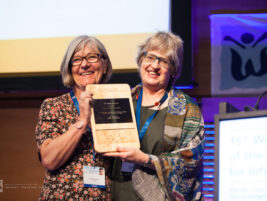Recently the book Nurturing Children and Families: Building on the Legacy of T. Berry Brazelton (Barry M. Lester and Joshua D. Sparrow, Eds.) was published by Wiley-Blackwell (West Sussex, UK, 2010). The book is a collection of chapters written by former students, colleagues and friends of the eminent American pediatrician T.Berry Brazelton following a tribute to Dr. Brazelton in Boston MA USA in 2008 marking his ninetieth birthday.
T. Berry Brazelton is known to millions of people worldwide as a clinician, scientist, advisor to parents; and major promoter of policy to support children and families.
When the copy of this book arrived at our flat in Budapest, my six year old daughter saw the book and heard it was about “Dr. T Berry” (as he is known in our household). She left the room and arrived a few moments later with her copy of Going to the Doctor. We read this book a number of times, before and after visits to my daughter’s pediatrician. The book was also special for my daughter because Dr. Brazelton and his grandson, Alfred (who drew the pictures in the book) had signed it when I was at the tribute conference for Dr. Brazelton in Boston. I told Alfred (and his grandfather) that my daughter ‘got a great deal’ from the pictures in the book and Alfred wrote: “I am glad you like my pictures, Anna, keep on drawing.” My six year old daughter feels her own connection to Dr. Brazelton (and his grandson).
The book is an astounding collection of thirty-one chapters that reflect Brazelton’s influence on many fields including child development, pediatrics, infant mental health, nursing, psychology, child psychiatry, social work, physical and occupational therapy, and policy. Each chapter was written by a colleague who has been influenced by Brazelton over the years and includes three generations of students, collaborators and colleagues. The book begins with a thoughtful tribute to Dr. Brazelton by Geoffrey Canada, President/CEO of Harlem Children’s Zone in New York City, USA.
A partial list of contributors include people surely known to readers of the Signal in a section of the book called “Infant mental health and the treatment of early trauma” [Charlie Zeanah & Paula Zeanah, Alicia Lieberman & William Harris; Joy Osofsky & Howard Osofsky; and Dante Cichetti & Sheree Toth]; and many who have contributed centrally to connections between infant assessment and infant mental health practice ;( J. Kevin Nugent; Kathryn Barnard; Heidi Als, Tiffany Field; Rose Bigsby; Amy Salisbury); others who have studied parent-infant interaction either developing Brazelton’s ideas (Edward Tronick; Tiffany Field) or reflecting on them (Daniel Stern). Also included is a chapter by Brazelton’s professional peer the late Stanley Greenspan.
I highly recommend this book to anyone – but especially to practitioners and teachers of infant mental health. The work of Dr. Brazelton on seeing, assessing and understanding infant development is integrated into many chapters in this book. In developing training in infant mental health, one can never ‘bring in’ enough experience and perspective on infant/child development and the effects of individual differences in infants on the developing infant-parent relationship; including:
(a.) Careful ‘differentiated’ observation of infants. From Brazelton and colleagues’ contributions in the seventies and eighties onward, no longer were babies seen as passive recipients of environmental input but they were shown to have active, organized ways to seek out and respond to stimulation from parents and the environment. Brazelton and colleagues were the first to develop an infant assessment (eventually called the Neonatal Behavioral Assessment Scale (NBAS) that took into account not only reflex functioning and muscle tone; but ‘organized’ responses to sensory input and ability to regulate or stabilize internal states of arousal. Included in this perspective was an appreciation of individual differences in newborn behavior (first described in Brazelton’s book Infants and Mothers) which brought the study of temperament in child behavior into the earlier period of infancy. Part of the generativity of this perspective on infant neurobehavior includes the development of other systematized assessments of different populations of infants and ‘prenates’: (the Assessment of Preterm Infant Behavior APIB; the NICU Network Neurobehavioral Scale (NNNS; for at-risk drug-exposed and preterm infants) and the Fetal Neurobehavioral Scale (FENS).
(b.) Knowing how knowledge of infant development effects one’s understanding of the interactions between infants and parents. Included in Brazelton’s focus on individual differences in infant behavior was an interest in how individual infants contributed to developing interactions between themselves and their parents. In the seventies, Brazelton thought that there were cycles of attention and inattention which were influenced in sustained interactions by both infants and parents. This perspective evolved into the mutual regulation model articulated by Edward Tronick and others and which contributed the still-face paradigm which allowed researchers and clinicians to observe the infant’s efforts to regain (or repair) active, mutual interaction with their parent. In the book, Daniel Stern provides a fresh look at parent-infant interaction reflected in the perspective of infant arousal dynamics. Others such as Tiffany Field used dimensions of infant neurobehavior aseessed by the NBAS to study interactions between infants and mothers struggling with depression.
(c.) Enabling practitioners to develop more differentiated and complex models of development as they learn to see and support relationships with parents and infants. Joshua Sparrow’s chapter describes the move in thinking about development from one-way causality to systems theory. Also, with Brazelton’s emphasis on touchpoints in development, there was a central emphasis on periods of development where there was disorganization followed by reorganization that included new abilities in the infant.
The touchpoints perspective and the emphasis on individual differences in infant behavior provided a huge challenge to existing models of development which needed to assume continuity from early infant behavior to later developmental attainment. Brazelton’s contributions were aided by other developmental theorists and advanced methodologists, especially Sameroff (the transactional model) and others which have indicated that it is not ‘biological status’ alone, but complex interactions between infant and environment, and infant and parent which help to predict later developmental status.
As part of his opening chapter, Barry Lester provides perspective on how behavioral epigenetics (interaction between fetus and prenatal biobehavioral environment) can contribute to an understanding of how the infant ‘’arrives’ in the postnatal world with the individual differences in newborn behavior seen and assessed by existing infant neurobehavioral assessments. Three sections of the book: Regression and reorganization in relational models of development (chapters by Mikael Heimann and Frans Plooj); Relational and contextual developmental models (chapters by Stanley Greenspan and Robert Levine) and Neuroscience perspectives on relational and developmental models (chapters by Allan Schore and Jerome Kagan) provide advanced understanding of connections between developing infants and their developing relationships.
(d.) Knowing how to build on solid models of development and parenting when building programs and services for families with young children. Brazelton and colleagues influence on the translation from infant development to models of care evidenced in chapters by Kathryn Barnard on the Nursing Child assessment Satellite Training (and Keys to Caregiving);Heidi Als and Rose Bigsby on care in the NICU for preterm infants and their parents; and three chapters on nurse home visiting programs (Kristie Brandt & J. Michael Murphy; David Olds; as well as Ann Stadtler, Julie Novak & Joshua Sparrow).
Joshua Sparrow as co-editor contributed a chapter which provides a central perspective on Brazelton’s emphasis on forming relationships and collaborative consultation. These ideas have grown through the evolution of the Touchpoints program; evidenced in a chapter by Jayne Singer and John Hornstein on the Touchpoints approach to early childhood care. Separate chapters indicate Brazelton’s influence on infant mental health training in early intervention and early head start (the late Libby Zimmerman); innovations in behavioral/developmental pediatric fellowship training (Constance Keefer); child life (Myra Fox); early child care and education (Francine Jacobs, Mallary Swartz, Jessica Dym Bartlett & M. Ann Easterbooks); and a thoughtful chapter by Daniel Pederson and Jack Shonkoff on translating the science of early child development into policy and practice. The book concludes with a chapter by Sara Lawrence-Lightfoot called Respect and Healing.
(e.) The conduct of research in applied development, early intervention and evaluation of infant mental health programs. Combining an emphasis on the importance of individual differences with one on complex interactions between the infant and environment has placed a demand for new methods and new models of development. Barry Lester’s opening chapter and several others in the book detail how researchers have worked to translate Brazelton’s contributions into sound research protocols.
To sum up the connection between the new book and infant mental health training and practice, I can but quote WAIMH’s own High Fitzgerald in his tribute on the back cover of the book: “Those who want to bask in and relive the exciting engagement with infants and families throughout the second half of the 20th century can do so in these chapters. Those who want to engage in the transformations required in the 21st century, read, imagine, and take action, know that Brazelton’s footsteps, though wide and encompassing, move quickly.”
The book is a valuable resource for training, for practice – and for reading and reflection. When I was preparing to write this review, I tended to read one chapter and then spend some time afterward reflecting on what I heard that was new; what confirmed my experience; what I disagreed with, and so on. Therefore, you could say I also recommended the book as a source of ‘daily’ reflection – and inspiration.
Post script. When I was a young Ph.D. at Dr. Brazelton’s Child Development Unit, at Children’s Hospital, Boston, I was astounded at his fellowship program. It was developed for clinicians from pediatrics and other disciplines, at the fellowship level, to study and experience what a colleague called ‘typical child development and parenting.” Brazelton, I think, was concerned that pediatric residents (and others in allied disciplines) had learned about diagnosing problems and treating known illnesses but this learning was not often balanced by learning about child development and the everyday concerns of parents. Early on, I asked: “Why would people at this stage of their career return for two years of sitting on the floor in day care centers; participating in the Early Childhood Service and learning to join with colleagues in many other disciplines in seeing and then, supporting children and their parents?” One simple answer was that Brazelton himself, and those around him; had created what one fellow called “A hotbed of child development.” The curriculum included how to learn from research and develop researchable questions in an applied context. All of the fellows have moved on to noteworthy careers as faculty, (often forming developmental/behavioral pediatric and applied child development training programs); researchers (in first rate applied research protocols); clinicians and policy advisors. In a similar light, this book is itself a “hotbed of child development and issues central to infant mental health practice.”
Two of the ‘Brazelton fellows’ have passed on recently. This review is a tribute to Dr. Brazelton and is also dedicated to the memory of Stephen Parker, M.D. and Bob Gatson, M.D..
Authors
Boukydis, Zack,
PhD, Visiting Professor,
Fullbright Fellow, Department of Pediatrics,
Semmelweiss University Medical School,
Budapest, Hungary,
E-mail: zboukydis@gmail.com.








